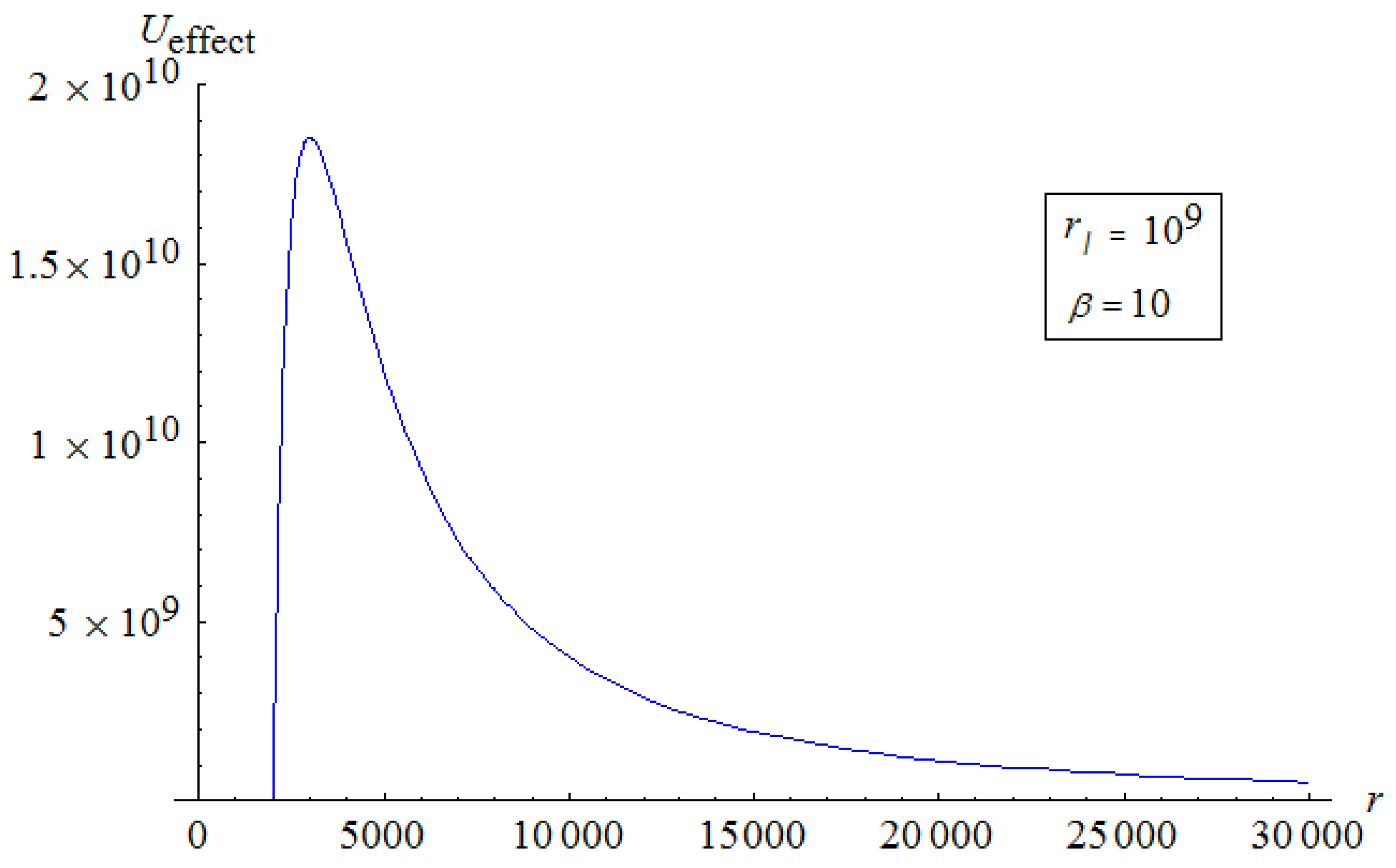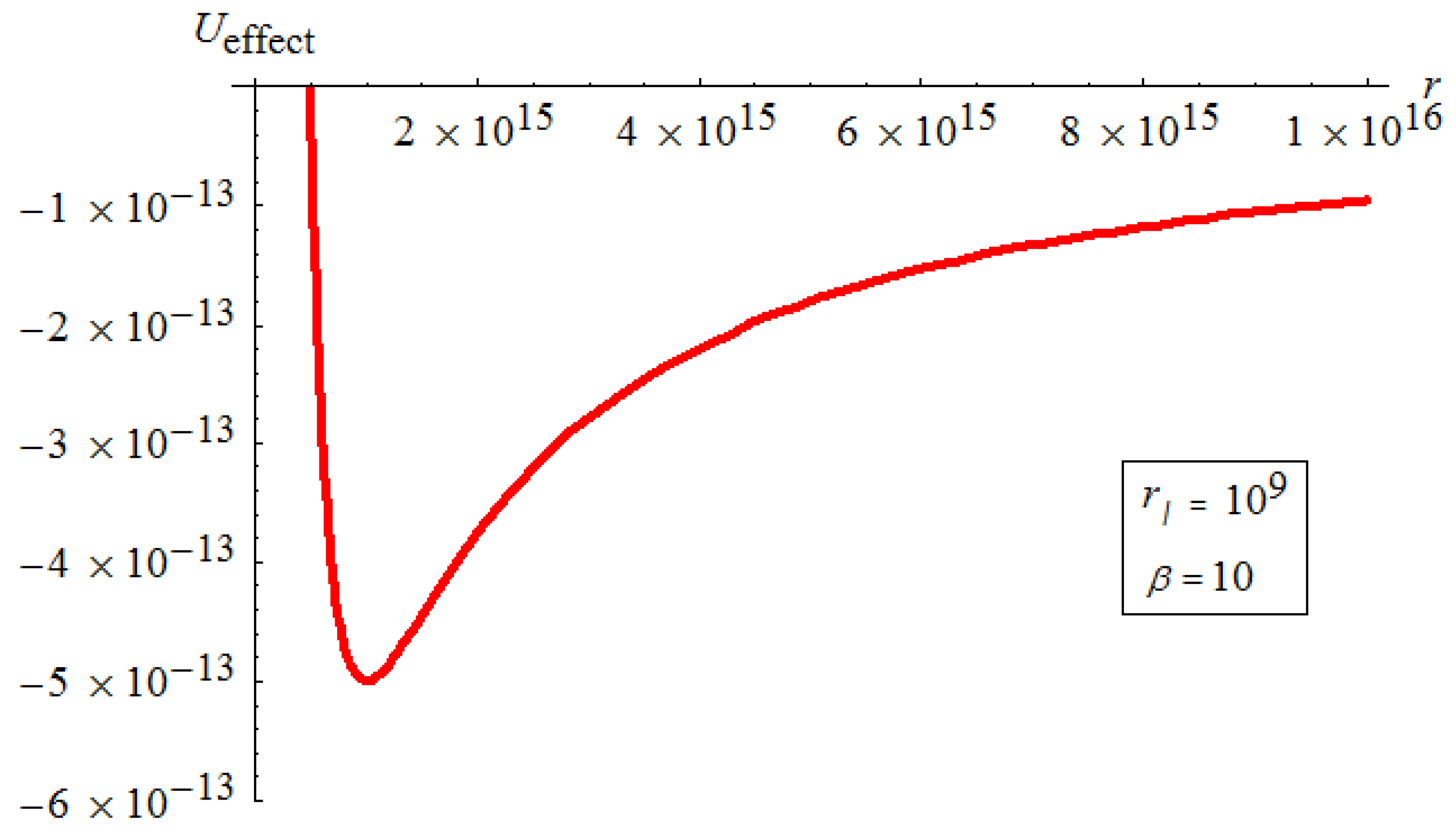The Astrophysical Scales Set by the Cosmological Constant, Black-Hole Thermodynamics and Non-Linear Massive Gravity
Abstract
:1. Introduction
2. The Schwarzschild De-Sitter Metric in Static Coordinates
3. Circular Orbit Conditions for the Effective Potential with
The Case with 0
4. The Role of in the Black-Hole Thermodynamics in S-dS Space
5. The Schwarzschild De-Sitter Solution in Massive Gravity
5.1. Solution with a Degenerate Vacuum
5.2. Solution with Single Vacuum
5.3. The Effective Potential in dRGT Massive Gravity
5.3.1. The Case of One Free-Parameter
5.3.2. The Case of Two Free-Parameters
6. Black-Hole Thermodynamics Inside the Non-Linear Formulation of Massive Gravity
7. The Number of Propagating Degrees of Freedom and Lorentz Violation
8. Conclusions
Acknowledgments
Conflicts of Interest
Appendix A. General Solution of a Fourth-Order Polynomial
Appendix B. General Solution of a Third-Order Polynomy
References
- Bażański, S.L.; Ferrari, V. Analytic Extension of the Schwarzschild-de Sitter Metric. Il Nuovo Cimento B 1986, 91, 126–142. [Google Scholar] [CrossRef]
- Arraut, I.; Batic, D.; Nowakowski, M. Comparing two approaches to Hawking radiation of Schwarzschild-de Sitter Black Holes. Class. Quantum Gravity 2009, 26, 125006. [Google Scholar] [CrossRef]
- Bousso, R.; Hawking, S.W. Pair creation of black holes during inflation. Phys. Rev. D 1996, 54, 6312–6322. [Google Scholar] [CrossRef]
- Bousso, R.; Hawking, S.W. (Anti)-evaporation of Schwarzschild-de Sitter black holes. Phys. Rev. D 1998, 57, 2436–2442. [Google Scholar] [CrossRef]
- Arraut, I. The Planck scale as a duality of the Cosmological Constant: S-dS and S-AdS thermodynamics from a single expression. arXiv, 2012; arXiv:1205.6905v3. [Google Scholar]
- Gibbons, G.W.; Hawking, S.W. Cosmological event horizons, thermodynamics and particle creation. Phys. Rev. D 1977, 15, 2738–2751. [Google Scholar] [CrossRef]
- Stuchlík, Z.; Slanký, P. Equatorial Circular orbits in the Kerr-de Sitter spacetimes. Phys. Rev. D 2004, 69, 064001. [Google Scholar] [CrossRef]
- Balaguera Antolinez, A.; Böhmer, C.G.; Nowakowski, M. Scales set by the Cosmological Constant. Class. Quantum Gravity 2006, 23, 485–496. [Google Scholar] [CrossRef]
- Babichev, E.; Deffayet, C. An introduction to the Vainshtein mechanism. Class. Quantum Gravity 2013, 30, 184001. [Google Scholar] [CrossRef]
- Vainshtein, A.I. To the problem of nonvanishing gravitation mass. Phys. Lett. B 1972, 39, 393–394. [Google Scholar] [CrossRef]
- Arraut, I.; Batic, D.; Nowakowski, M. Velocity and velocity bounds in static spherically symmetric metrics. Cent. Eur. J. Phys. 2011, 9, 926–938. [Google Scholar] [CrossRef]
- Stuchlík, Z. The motion of test particles in Black Hole Backgrounds with non-zero Cosmological Constant. Bull. Astron. Inst. Czech. 1983, 34, 129–149. [Google Scholar]
- Stuchlík, Z.; Hledík, S. Some properties of the Schwarzschild de-Sitter and Schwarzschild Anti de-Sitter spacetimes. Phys. Rev. D 1999, 60, 044006. [Google Scholar] [CrossRef]
- Stuchlík, Z. An Einstein Strauss de-Sitter model of the universe. Bull. Astron. Inst. Czech. 1984, 35, 205–215. [Google Scholar]
- Stuchlík, Z.; Calvani, M. Null geodesics in black hole metrics with non- zero Cosmological Constant. Gen. Relativ. Gravit. 1991, 23, 507–519. [Google Scholar] [CrossRef]
- Hua, C.J.; Jiu, W.Y. Inuence of Dark Energy on time-like geodesic motion in Schwarzschild spacetime. Chin. Phys. B 2008, 17, 1184–1188. [Google Scholar]
- Slanacutey, P.; Stuchlík, Z. Relativistic thick discs in Kerr- de Sitter backgrounds. Class. Quantum Gravity 2005, 22, 3623–3651. [Google Scholar]
- Kraniotis, G.V. Periapsis and gravitomagnetic precessions of stellar orbits in Kerr and Kerr-de Sitter black hole spacetimes. Class. Quantum Gravity 2007, 24, 1775–1808. [Google Scholar] [CrossRef]
- Kraniotis, G.V. Precise analytic treatment of Kerr and Kerr-(anti) de Sitter black holes as gravitational lenses. Class. Quantum Gravity 2011, 28, 085021. [Google Scholar] [CrossRef]
- Chauvineau, B.; Regimbau, T. Local effects of a Cosmological Constant. Phys. Rev. D 2012, 85, 067302. [Google Scholar] [CrossRef]
- Stuchlík, Z.; Slaný, P.; Hledík, S. Equilibrium configurations of perfect fluid orbiting Schwarzschild de-Sitter black holes. Astron. Astrophys. 2000, 363, 425–439. [Google Scholar]
- Arraut, I. On the apparent loss of predictability inside the de-Rham-Gabadadze-Tolley non-linear formulation of massive gravity: The Hawking radiation effect. Europhys. Lett. 2015, 109, 10002. [Google Scholar] [CrossRef]
- Arraut, I. Path-integral derivation of black-hole radiance inside the de-Rham-Gabadadze-Tolley formulation of massive gravity. arXiv, 2015; arXiv:1503.02150. [Google Scholar]
- Arraut, I. Komar mass function in the de Rham–Gabadadze–Tolley nonlinear theory of massive gravity. Phys. Rev. D 2014, 90, 124082. [Google Scholar] [CrossRef]
- Carroll, S. Space-Time and Geometry; Addison Wesley: Chicago, IL, USA, 2004. [Google Scholar]
- Ginsparg, P.; Perry, M.J. Semiclassical perdurance of de Sitter space. Nucl. Phys. B 1983, 222, 245–268. [Google Scholar] [CrossRef]
- Kodama, H.; Arraut, I. Stability of the Schwarzschild-de Sitter black hole in the dRGT massive gravity theory. Prog. Theor. Exp. Phys. 2014, 2014, 023E02. [Google Scholar] [CrossRef]
- Nowakowski, M.; Arraut, I. The minimum and maximum temperature of Black body radiation. Mod. Phys. Lett. A 2009, 24, 2133–2137. [Google Scholar] [CrossRef]
- Hinterbichler, K. Theoretical Aspects of Massive Gravity. Rev. Mod. Phys. 2012, 84, 671–710. [Google Scholar] [CrossRef]
- Rubakov, V.A.; Tinyakov, P.G. Infrared-modified gravities and massive gravitons. Phys. Usp. 2008, 51, 759–792. [Google Scholar] [CrossRef]
- Rubakov, V. Lorentz-violating graviton masses: getting around ghosts, low strong coupling scale and VDVZ discontinuity. arXiv, 2004; arXiv:hep-th/0407104. [Google Scholar]
- Arraut, I.; Chelabi, K. Non-linear massive gravity as a gravitational σ-model. Europhys. Lett. 2016, 115, 31001. [Google Scholar] [CrossRef]
- Arraut, I. The graviton Higgs mechanism. Europhys. Lett. 2015, 111, 61001. [Google Scholar] [CrossRef]
- Cai, R.-G.; Hu, Y.-P.; Pan, Q.-Y.; Zhang, Y.-L. Thermodynamics of black holes in massive gravity. Phys. Rev. D 2015, 91, 024032. [Google Scholar] [CrossRef]
- Vegh, D. Holography without translational symmetry. arXiv, 2013; arXiv:1301.0537v2. [Google Scholar]
- Fernando, S. Phase transitions of black holes in massive gravity. Mod. Phys. Lett. A 2016, 31, 1650096. [Google Scholar] [CrossRef]
- Hendi, S.H.; Li, G.Q.; Mo, J.X.; Panahiyan, S.; Panah, B.E. New perspective for black hole thermodynamics in Gauss–Bonnet–Born–Infeld massive gravity. Eur. Phys. J. C 2016, 76, 571. [Google Scholar] [CrossRef]
- Sanchez, A. Geometrothermodynamics of black holes in Lorentz noninvariant massive gravity. Phys. Rev. D 2016, 94, 024037. [Google Scholar] [CrossRef]



© 2017 by the author. Licensee MDPI, Basel, Switzerland. This article is an open access article distributed under the terms and conditions of the Creative Commons Attribution (CC BY) license (http://creativecommons.org/licenses/by/4.0/).
Share and Cite
Arraut, I. The Astrophysical Scales Set by the Cosmological Constant, Black-Hole Thermodynamics and Non-Linear Massive Gravity. Universe 2017, 3, 45. https://doi.org/10.3390/universe3020045
Arraut I. The Astrophysical Scales Set by the Cosmological Constant, Black-Hole Thermodynamics and Non-Linear Massive Gravity. Universe. 2017; 3(2):45. https://doi.org/10.3390/universe3020045
Chicago/Turabian StyleArraut, Ivan. 2017. "The Astrophysical Scales Set by the Cosmological Constant, Black-Hole Thermodynamics and Non-Linear Massive Gravity" Universe 3, no. 2: 45. https://doi.org/10.3390/universe3020045




